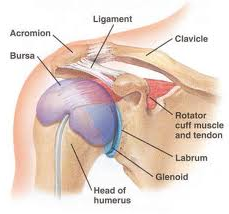The rotator cuff is an anatomical structure of the shoulder that provides stability and a wide range of motion in the arm. The shoulder joint is one of the most sophisticated structures in the body, and it is a connection between three bones, which are the humerus, the scapula and the clavicle. There are also multiple ligaments and muscle tendons that allow for a wide range of movement in the arm, such as full rotation around the axis of the joint.
Unfortunately, shoulder surgeons treat a lot of patients who exhibit rotator cuff problems because it is a highly vulnerable region, especially in athletes who use the arms in their athletic performance and individuals who lift weights regularly as part of their daily work habits. The rotator cuff has numerous tendons and ligaments, which can become overstretched, lose their stabilization properties or become inflamed and swollen, which translates into pain and the inability to perform a variety of motions involving the shoulder. How can a shoulder surgeon help with rotator cuff repair?
Rotator Cuff Problems Are Generated by Repetitive Shoulder Movements
Which individuals potentially susceptible to rotator cuff problems and shoulder injuries? The greatest tension in the shoulder is  experienced when performing overhead movements, because it involves the maximal stretch of shoulder ligaments that hold the humerus head in place. These ligaments can become excessively stretched in swimmers, since this sport requires repetitive shoulder work to overcome the resistance of water during propulsion.
experienced when performing overhead movements, because it involves the maximal stretch of shoulder ligaments that hold the humerus head in place. These ligaments can become excessively stretched in swimmers, since this sport requires repetitive shoulder work to overcome the resistance of water during propulsion.
Rotator cuff repair performed by a highly skilled shoulder surgeon is non-invasive and may be necessary when conservative measures have failed to induce a natural healing of the ligaments and alleviate the bothersome inflammation of the shoulder joint.
Rotator cuff problems results in shoulder instability, which means that an individual is vulnerable to shoulder subluxation or dislocation at any time. Moreover, some muscle tendons that run through the shoulder joint can become compressed by the bone structures, which further aggravates rotator cuff issues and makes full rotation movements virtually impossible.
Surgery for Rotator Cuff Problems Is Usually After 6 Months of Conservative Treatment
Orthopedic surgeons usually recommend trying physical therapy first to strengthen the small rotator cuff muscles before resorting to painkillers or a surgical approach. In some cases, substantial pain relief and a restoration of shoulder function can be achieved by strengthening the small muscles, such as the supraspinatus, infraspinatus, the rhomboid and the rear portion of the deltoid muscle. These muscles work as stabilizers for the rotator cuff and shoulder joint, and their gradual development can  provide enough support for full rotational arm movement without pain. If these exercises don’t work and the pain persists after six months of physical therapy, surgeons will perform a surgery that is aimed at correcting the overstretched ligaments and preserve the shoulder stability.
provide enough support for full rotational arm movement without pain. If these exercises don’t work and the pain persists after six months of physical therapy, surgeons will perform a surgery that is aimed at correcting the overstretched ligaments and preserve the shoulder stability.
According to medical studies, rotator cuff surgery is suggested in cases where severe shoulder disability is diagnosed in athletes or workers who use their shoulders repetitively. If you experience shoulder pain, don’t hesitate to undergo a thorough evaluation of your rotator cuff through a physical examination.
See Also: Does A Shoulder Labral Tear Mean You Are Out For The Season?

